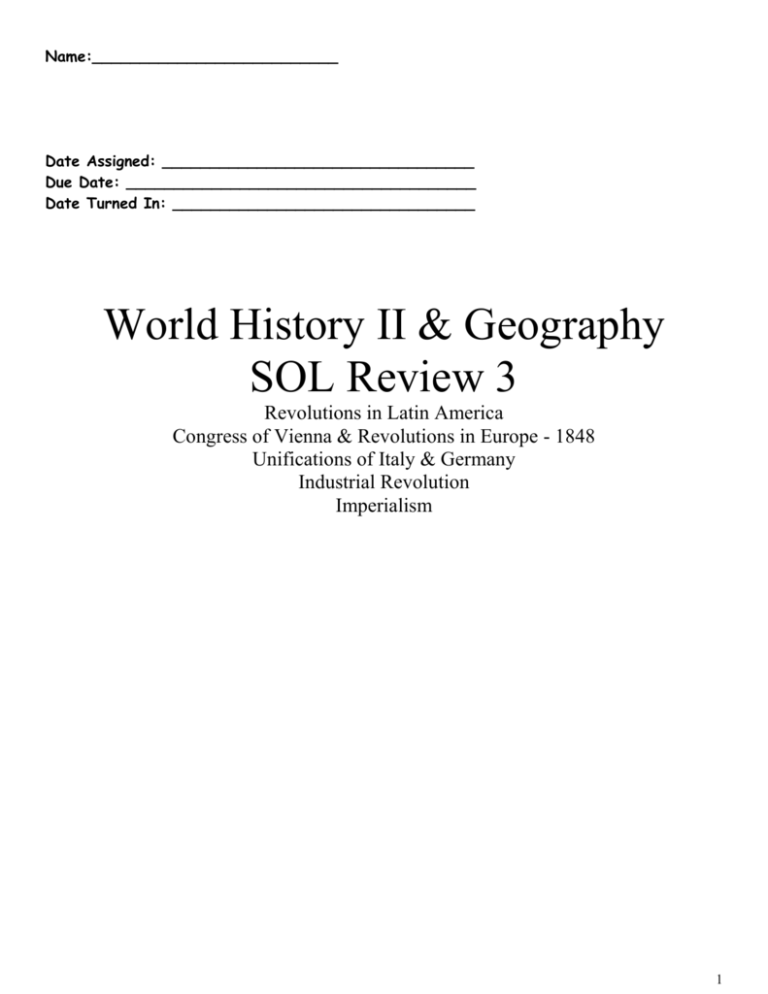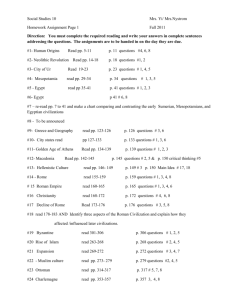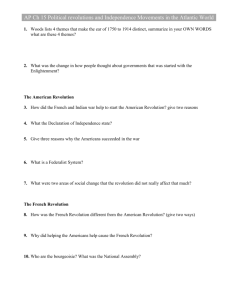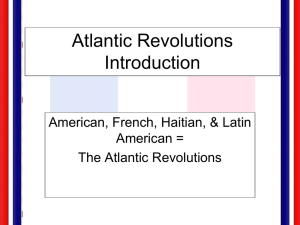WHII SOL Review Packet 3
advertisement

Name:__________________________ Date Assigned: _________________________________ Due Date: _____________________________________ Date Turned In: ________________________________ World History II & Geography SOL Review 3 Revolutions in Latin America Congress of Vienna & Revolutions in Europe - 1848 Unifications of Italy & Germany Industrial Revolution Imperialism 1 WHII 7a-d Latin America Revolutions Summary: Latin American revolutions of the 19th Century were influenced by a rigid class system in the development of governments and ruling powers. Spanish conquests in Latin America saw the rapid decline of native populations and introduction of slaves from Africa. Conquistadors were given governmental authority by the Spanish crown. They were now called Viceroys. What were the characteristics of the colonial system in Latin America in the 19th Century? Circle or highlight the key words below. Colonial governments mirrored the home governments. Catholicism had a strong influence on the development of the colonies. Mining of precious metals (gold and silver) for export Rigid class system Major cities in that were established as outposts of colonial authority: Havana, ______________ Mexico City, ___________ Lima, Peru Sao Paulo, Brazil Buenos Aires, Argentina Viceroys/Colonial Officials Creole Which class were the revolutionaries? Why? Mestizo/Mulatto 2 The American and French Revolutions took place in the late 1700’s. Within twenty years, the ideas and examples of these revolutions influenced the people of Latin America to establish independent nations in Haiti, Mexico and South America. What did Toussaint L’Ouverture accomplish in Haiti? Which European countries lost colonies? F________ S________ and P_________ B________ What were the contributions of Simon Bolivar to revolutions in Latin America? Which new countries gained independence? H________ What were the contributions of Father Hidalgo to revolution in Mexico? B____________, V____________ & C________________ M_______________ After the American Revolution the United States wished to prevent foreign interference in America. The Monroe Doctrine was issued in 1823, alerting European powers that the American continents should not be considered for any future colonization. Explain the Monroe Doctrine in your own words: _______________________________________________________________________________________________ _______________________________________________________________________________________________ What was the impact of the Monroe Doctrine on Latin America? 3 Challenge Yourself! Put the following events in the correct order. ___1____ The Scientific Revolution __________ Napoleon’s French Empire __________ American Revolution (1776) __________ Revolutions in Latin America _____4_____ French Revolution (1789) __________ The Enlightenment WHII 8a-d Political and Philosophical Developments in Europe Summary: The French Revolution left a powerful legacy for world history, including secular society, nationalism and democratic ideas. Napoleon’s attempt to unify Europe under French domination was unsuccessful. The Congress of Vienna attempted to restore Europe as it had been before the French Revolution and Napoleonic conquests. What is a coup d’etat? What did Napoleon try to do? Was he successful? Which nations was he NOT able to conquer? The Napoleonic Code A uniform set of l______. The Napoleonic Code promoted order over individual rights. How else could Napoleon rule his vast empire?! 4 The Congress of Vienna The Congress of Vienna was led by Klemens von M____________________ of Austria. It was a Peace Conference - meeting of ambassadors from European countries after Napoleon tried to unify Europe under French control, but failed. What did the Congress of Vienna want to do? “B________ of Power” Restore M___________ Make sure that no single nation would ever dominate Europe again. There would be no more Napoleons! Bring back the monarchies that had existed before Napoleon’s conquests. Legitimate monarchies would stabilize political relations among the nations Redraw the Map Return the territories that Napoleon had captured & make France the size it was before the empire. New Political Philosophies L_____________________ Believed in the NEW ideas of the French Revolution: liberty, equality & fraternity. C______________________ Did not believe in the ideas that came from the French Revolution - liked the OLD ideas, like monarchy. 1848 - Revolutions and Rise of Nationalism Widespread demands for political rights led to revolutions and legislative actions in Europe. Nationalism: ____________________________________________________________________ The terms of the Congress of Vienna led to widespread discontent in Europe, especially in Italy and the German states. Unsuccessful revolutions of 1848 increased nationalistic tensions. In contrast, the United Kingdom expanded political rights through legislative means (the branch which has the power to create and pass laws). The UK made slavery illegal in the British Empire. Circle and label the locations of: Europe, Latin America, North America, Asia and Africa. 5 Unification of Italy and Germany Summary: Italy and Germany became nation-states long after the rest of Europe. Unification of Italy ___________________ unified Northern Italy. Giuseppe Garibaldi unified Southern Italy then joined it to Northern Italy. The P___________ States (including Rome) were the last to join Italy. What is Realpolitik? What wars did Bismarck start as he unified Germany Who were the Red Shirts? Who was their leader? Unification of Germany Otto von B__________________ led Prussia in the unification of Germany through war and by appealing to nationalist feelings Bismarck’s actions were seen as an example of Realpolitik - justifies all means to achieve and hold power. The Franco-Prussian War led to the creation of the German State 6 WHII 9 a-e Industrial Revolution Summary: The Industrial Revolution began in England and spread to the rest of Western Europe and the United States. With the industrial Revolution came an increase demand for raw materials from the Americas, Asia and Africa. Advancements in technology produced the Industrial Revolution, while advancements in science and medicine altered the lives of people living in the new industrial cities. Cultural changes soon followed. Why did the Industrial Revolution start in England? (3 reasons) * * * KEY POINTS Spread to E__________ & the U____________ S________________ The cotton t________________ industry was the first to become “industrialized” Advances in iron and steel industries led to the development of other industries transportation Rise of the factory system (mass production of goods by machine in factories) and end of cottage industries (production of goods by hand by farming families at home) Spread of industrialization led to colonialism & i__________________________ Rising economic powers wanted raw m______________ & new markets to sell manufactured goods Technological advances that produced the Industrial Revolution James Hargreaves Spinning Jenny (used in making t________) James Watt S_________ Engine Eli Whitney Cotton G_______ Henry Bessemer Process for making s_______ Advances in Science & Medicine Edward J___________________ - Developed smallpox vaccination Louis P___________________ - Discovered bacteria; made milk safe to drink Impacts of the Industrial Revolution I ncrease in population, education & m_________ class N ew advancements in science D angerous working conditions U _________________ (growth of cities) S tandard of living i________________ (how much people could buy) T ransportation improved R ise of pollution Y eah, steel production improved 7 • • • Nature of Work in the Factory System Harsh working conditions with men competing with women and children for wages. Child labor kept the cost of production low and profits high. Owners of mines and factories had considerable control over the lives of their laborers. Impact on Slavery C_____________ G_____ increased the demand for slaves labor in American plantations. United States & Britain outlawed the slave trade and then slavery. Impact on Society Rise of Labor Unions Women and _________________ entered the workplace as cheap labor Organized groups of workers who push owners for better working conditions for all. Reforms to end child labor What is a strike? Expansion of education Women’s increased demands for rights & s______________ - the right to vote What is collective bargaining? Capitalism v. Socialism/Communism Summary: Capitalism and market competition fueled the Industrial Revolution. Wealth increased the standard of living for some, but not all. Capitalism produced a range of economic and political ideas, including socialism and communism, because the working class was exploited. • • • • • Capitalism Based on “W_______________ of N__________________” Role of market competition & entrepreneurial abilities Private ownership of property Capitalism and market competition fueled the Industrial Revolution A____________ S______________ wrote “Wealth of Nations” • • • • Socialism/Communism Based on C______________________ M_________________________ (written with Friedrich Engels) and Das Kapital Response to the injustices of capitalism Redistribution of wealth “From each according to his ability, to each according to his needs” Becomes the basis of revolution in Russia, China and other nations in the 20th century K___________ M___________ wrote “Communist Manifesto” 8 Imperialism Summary: Industrial nations in Europe needed natural resources and markets to expand their economies. These nations competed to control Africa and Asia in order to secure their own economic and political success. Imperialism spread economic, political and social philosophies of Europe throughout the world. Resistance to imperialism took many forms, including armed conflict and intellectual movements. Causes of Imperialism Nationalism Competition among European powers Raw Materials & New Markets were needed Christian missionary efforts Imperialism in Asia and Africa Forms of Imperialism C_____________- areas under the direct control of the mother country P______________________________________areas that have some self-governance under the watchful eye of the mother country S_________________ of I___________________- areas within a country where another country has economic or political control (trade) European conflicts carried over to the colonies o Spheres of Influence in China Qing Dynasty limited entry into China o A______________opens Japan to trade with the Treaty of Kanagawa o British E______ I______ Company dominates the Indian States o Suez Canal - located in E_____________; connects the “M________ with the Red” Started by France but completed and controlled by Britain Colonized People Respond With Armed Conflict CHINA o Opium War btwn China & Britain o B________ Rebellion INDIA S______________ Rebellion leads to India becoming a British colony Rise of Nationalism Indian N______________ C______________ o First Indian nationalist party founded in the mid 1800’s o Led by Mahatma Gandhi 9








